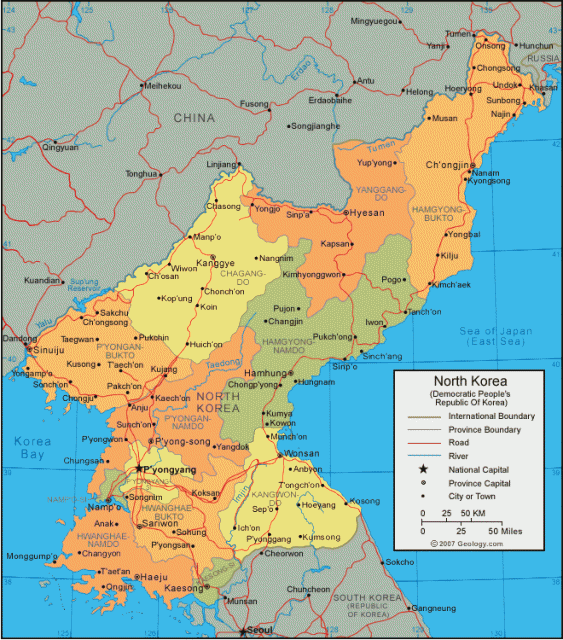Korea, North
Area 46,541 square mi (120,540 square km)
Population 25.03 million 2014
Capital P'yongyang
Highest Point 9,055 ft (2,744 m)
Lowest Point 0 m
Primary Natural Resources coal, lead, tungsten, zinc, graphite.
THE DEMOCRATIC People's Republic of Korea, North Korea, is one of the world's most politically isolated countries. Separated from its sister nation (South KOREA) to the south since 1953, the Democratic People's Republic holds on to its Cold War ideologies long after its chief sponsors have either collapsed (the Soviet Union) or turned toward liberalized economy and better relations with the West (such as CHINA). Less populated and less developed economically than the south even before the split, North Korea is almost completely unable to feed its population because of extreme economic centralization and international blockades.

North Korea occupies the northern portion of the Korean peninsula, roughly from the 38th parallel (38 degrees north latitude, the Demarcation Line of July 27, 1953) to the border with Manchuria (China) and SIBERIA (RUSSIA). Its is bordered on the east and west by the Sea of Japan and the Yellow Sea. Most of its northern border is with China, with only 11.8 mi (19 km) bordering Russia, in the far northeastern corner. The southern border with the Republic of Korea (South Korea) is 151 mi (248 km) long, along the demilitarized zone (the DMZ), still the area of the world with the highest concentration of permanent military presence, with North Korea's 1.1 million-person army (the world's fifth largest) facing off against 600,000 South Korean troops and a sizable American military force. The terrain is mostly hilly, with higher mountains in the interior, separated by deep, narrow valleys. There are wider coastal plains in the west, in which is located the country's only major city, P'yongyang, and its port city, Namp'o.
The mountains of North Korea are generally higher than in the south—as a result, most of the best farmland is in the south (only about one-sixth of the land in the north is suitable), while the north is richer in timber and minerals (coal, iron, copper, zinc, and other ingredients for heavy industry). The mountain ranges that run the length of the Korean peninsula from north to south are mostly along the eastern edge of the country, with the terrain sloping gradually toward the west. The eastern coast is thus generally more steep, while the west coast has more coastal indentations and small islands (though in no way comparable to the thousands in the south). The central range for the northern end of the peninsula is called the Nangnim Range.
The highest mountains, however, are further to the northeast, including Paektu-san (Korea's highest), on the border with China, from which emanate the two main rivers in the north that form most of the border with China, the Yalu River, flowing west into the Korea Bay and into the Yellow Sea, and the Tumen River, east to the Sea of Japan, its mouth only 80 mi (129 km) from Vladivostok, Russia's major city in the Far East. Both of these rivers are navigable for a considerable distance, and both provide China and North Korea with hydroelectric power. Many of the mountains in this far northeastern corner are extinct volcanoes.
Further south, North Korean territory includes the northernmost end of the Taebaek Range, mountains of medium height that hug the eastern coast, including one of the best known mountains in all of Korea, the Kumgang-san (Diamond Mountain), with its “12,000 peaks,” famous scenery, spring foliage, and ancient legends about odd-shaped rocks and ravines. The Taedong River, flowing through the center of P'yongyang, is not the longest in North Korea, but it is the major transport river from the interior, past the capital and into the Korea Bay. The capital is the only city with over a million inhabitants in the north (versus six in South Korea).
Though most of the cultural and political centers in Korean history have been in the southern end of the peninsula, P'yongyang was the center of the Goryeo kingdom (the origin of the name Korea), dominating this region and much of Manchuria before the seventh century. The North prefers to use the name of Korea's former ruling dynasty, Joseon, or Choson, with more ties to these northern kingdoms, rather than the name preferred by the South, Han'guk. The Choson ruled a united peninsula until the Japanese conquest in 1910.
After 1945, Korea was divided into spheres of influence by the UNITED STATES and the Soviet Union at the 38th parallel. The Soviets refused to submit to United Nations elections to decide on the form of government, so a republic was set up in the south in 1948, followed a few weeks later by the north. War from 1950 to 1953 effected little change in the nation's divided status but caused a massive depopulation of the north when nearly 1 million refugees fled south.
Political and economic mismanagement for the past 50 years has driven the country's industries into the ground: official government estimates for famines between 1995 and 1998 claim the loss of over 200,000 lives, while international groups claim much higher figures, around 1.5 million. The population has shifted dramatically from 20 percent urban in 1953 to 60 percent in 1987. Reunification talks have become a possibility only in the last few years, with the first meeting between the two presidents in 2000. Korean athletes marched together for the first time at the Sydney Olympic Games in 2000, and limited border crossings have begun, allowing families to visit relatives they have not seen in over 50 years.